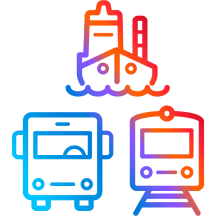
INTERMODAL
TRANSPORT
OF PEOPLE
AND GOODS
PROFITABLE
TO ALL
The stated objective is to drastically reduce greenhouse gas emissions in the transport sector, which currently accounts for 25% of the EU total: -55% by 2030, -90% by 2050.
Intermodality, which involves combining several modes or forms
of transport, is a key element in the carbon draw-down sought
by the European Union. It has to further connectivity along strategic
corridors, encourage a modal shift from road to rail, and promote
inland waterways. The passenger transport system is not to be
outdone, with public investment in infrastructure, new digital
technologies and intermodal links for urban mobility.
Challenges and opportunities
PEOPLE
In both urban and interurban areas, intermodality has become increasingly important in recent years. Passengers can now combine a number of forms of transport for one and the same journey - conventional, mass transit or soft modes – yet the use of cars remains predominant and seems almost unchallengeable for certain purposes.
GOODS
The EU has set a target of a 90% reduction in CO2 emissions from heavy goods vehicles by 2040, an ambitious project that is outdated and even counter-productive in the face of a European infrastructure network that is still not adapted to intermodal transport. Trains and barges are unable to compete with trucks and HGVs in terms of cost, speed and flexibility. Efforts to restrict road freight have not been enough to remove the regulatory and infrastructural obstacles that penalize other forms of transport.